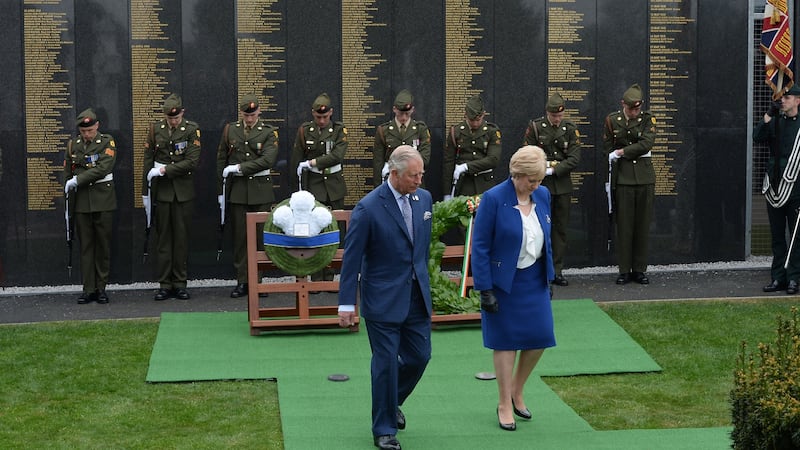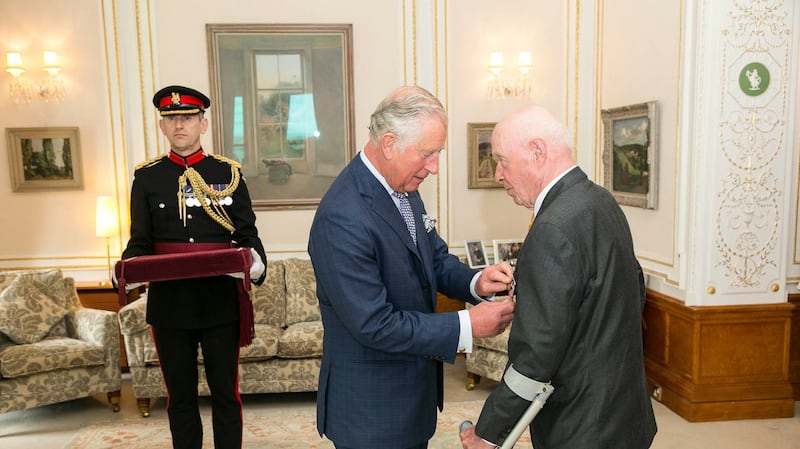Prince Charles described remembering the Irish and British dead of the first World War and Easter Rising at Glasnevin Cemetery in Dublin as "deeply moving" and "most memorable moment" of his four-day visit.
The next in line to the British throne laid wreaths at ceremonies at the Cross of Sacrifice for the war dead and at the Necrology Wall, which honours the 488 people, both Irish and British, killed in the 1916 Rising.
It was his first visit to the cemetery and the most recent by a British royal since Prince Edward, the Duke of Kent, in 2014.


"It is so very important that we are able to come together to honour the memory of so many men and women from all sides whose sacrifice shaped our shared history," he said later at the final engagement of his trip, at the British ambassador's Dublin residence, Glencairn.
The prince's last day in Ireland was dominated by acts of reconciliation that recognise the complex history between the two countries.
Sinn Féin president Gerry Adams made his first visit to the ambassador's residence in Sandyford, south Co Dublin, a place where the IRA killed former ambassador Christopher Ewart-Biggs in 1976.
Mr Adams and Prince Charles shared a few words as the Sinn Féin TD was one of four Irish political leaders to greet the prince at the residence.
‘Regrettable events’
"These are all regrettable events," he said, referring to the killing of Ewart-Biggs and the deaths of an IRA hunger striker and the killings of Belfast Catholics by British soldiers in Ballymurphy in 1971.
“Thank God, they are behind us and I think one of the key points out of visits like this, and engagements like this, is that we are showing a way to keep moving forward, in a peaceful way, a harmonious way, a way that brings people together.”
The royal joked with the republican on the lawn of Glencairn that they were both born in the same year, but that Mr Adams was a month older.
“He was slagging me that I was marginally older than him,” said the Sinn Féin leader. The prince also commiserated with him over the death of Martin McGuinness and told Mr Adams that he had written to his widow.
Mr Adams said that the prince's visit, like his trip to Mullaghmore in Sligo in 2015 – where his grand-uncle was killed by the IRA in 1979 – was "about reconciliation".
Reconciliation
He stressed that there also needed to be reconciliation in the streets, along country lanes and at a community level. “This sets a good example for everyone,” he said of this latest royal visit.
Speaking to about 200 guests in a marquee set up at Glencairn, Tánaiste Frances Fitzgerald paid tribute to the prince for visiting Glasnevin.
“[It] added significantly to the important but complex work of building peace and reconciliation that is so vital for both of our countries,” she said.
The visit, she said, “maturely acknowledged that complexity” by honouring the lives of Irish men in British uniform killed during the first World War and the people killed in the Easter Rising.
She referred to Co Meath poet Francis Ledwidge, killed fighting the first World War, who wrote about Rising leader Thomas McDonagh, and his line: "Tomorrow will be loud with war, how will I be accounted for?"
The visit was a “generous and moving response” to that, she said.
“In a world loud with controversy and change, respect, kindness and generosity still matter, still add up to how we should be accounted for.”
Gallantry
At Glasnevin, the prince, accompanied by his wife Camilla, the Duchess of Cornwall, unveiled memorial stones to four Irish-born recipients of the Victoria Cross, the highest British honour for gallantry.
He laid wreaths with Minister for Arts Heather Humphreys to honour the Irish and British dead of the first World War and the Easter Rising.
Afterwards, the prince spoke to Rev Patrick Harvey, whose grand-uncle Frederick Harvey, an Irish rugby international before the war, was one of the four Irish-born Victoria Cross recipients.
"He asked me what regiment Fred was in," said Rev Harvey, a Church of Ireland rector in Abbeyleix, telling him that he was in Lord Strathcona's Horse, the Canadian regiment of which the prince is colonel-in-chief.
“He said, ‘Oh yes, I think I am in charge of them.’”
Prince Charles travelled on from Glasnevin to Government Buildings where he met by Taoiseach Enda Kenny and signed the visitors’ book.
“This is just to prove I can write,” he joked as he signed “Charles”.











